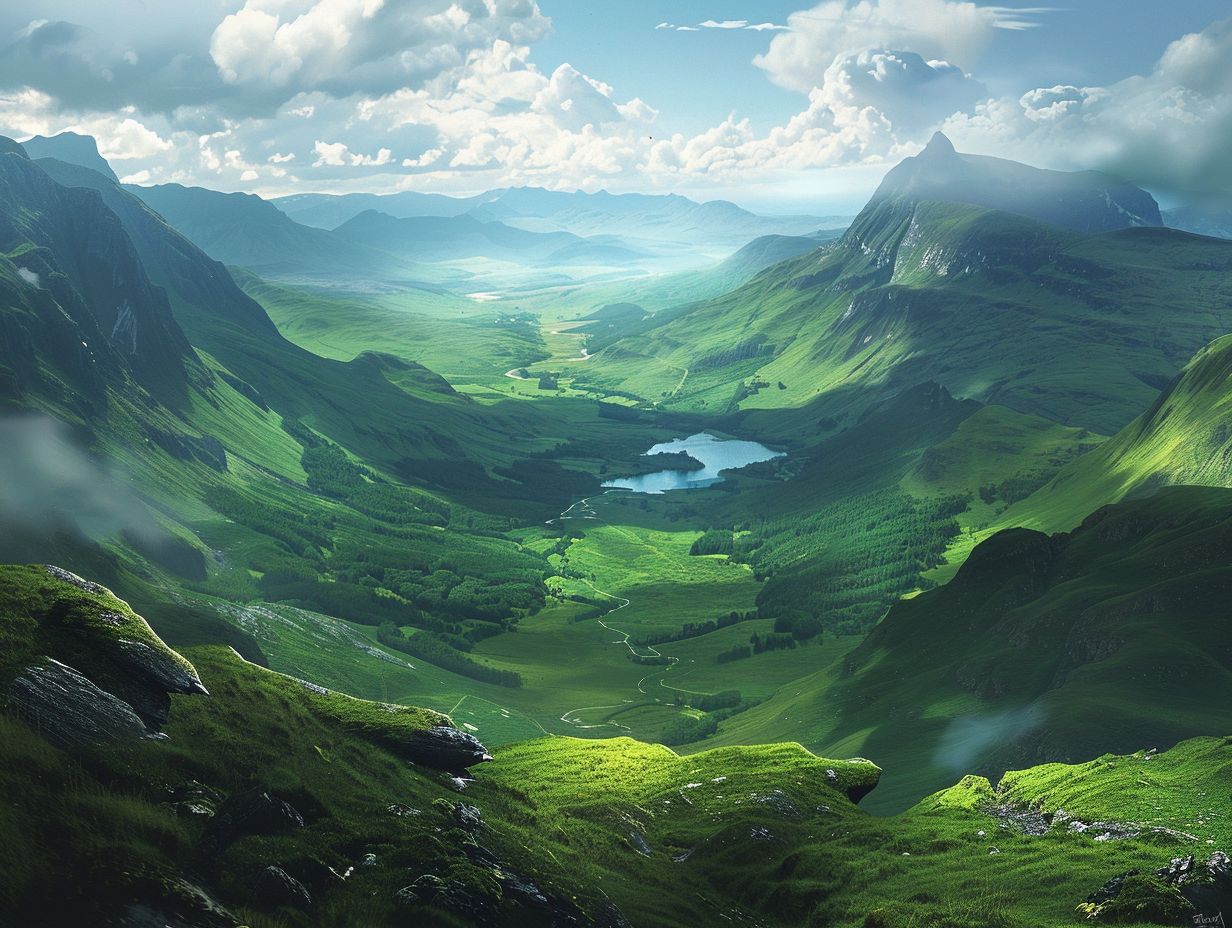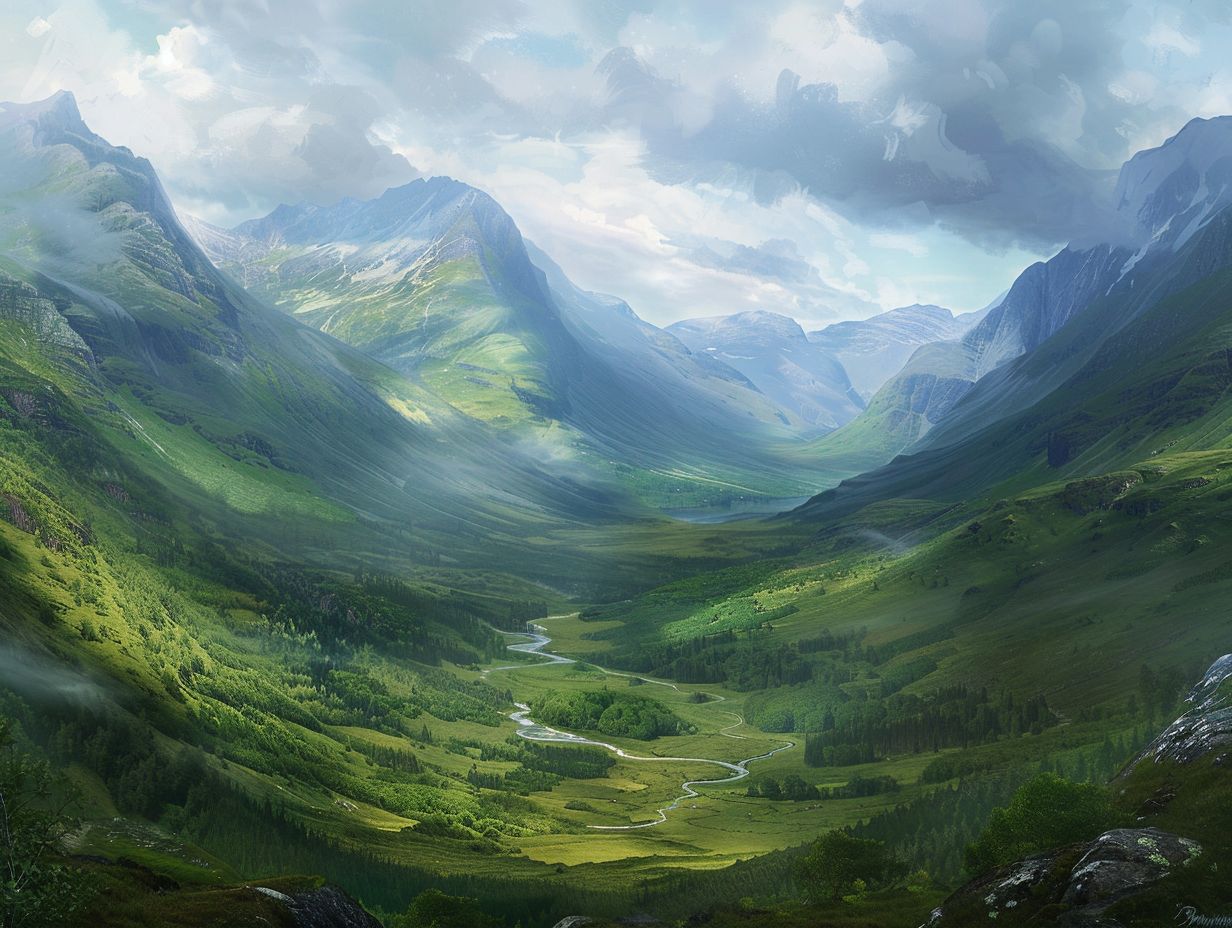Exploring the breathtaking Scottish Highlands on foot is an experience like no other. Before you lace up your hiking boots and hit the trails, it’s important to be prepared. From planning your route and packing the right gear to staying safe and respecting the environment, there are several key tips you should keep in mind.
In this article, we will explore the top hiking trails in the Scottish Highlands, the best times of year to hike, safety tips, must-see sights, and how to prepare for the unique challenges of this stunning region.
So, grab your backpack and prepare for an adventure in the Scottish wilderness!
Key Takeaways:
 1.
1.
- Plan your route and check the weather before embarking on a hike in the Scottish Highlands.
- Pack the right gear and supplies, including appropriate clothing and footwear, for a comfortable and safe hiking experience.
- Be prepared for changes in terrain and weather, and inform someone of your plans before heading out.
1. Plan Your Route and Check the Weather
When embarking on a hiking adventure in the Scottish Highlands, it is crucial to meticulously plan your route, considering the diverse trails and breathtaking landscapes awaiting exploration. Checking the weather forecast beforehand is essential to ensure a safe and enjoyable journey.
Popular trails like the West Highland Way offer stunning views of lochs, mountains, and forests, attracting hikers from around the world. The unpredictable nature of Scottish weather can present challenges, with conditions changing rapidly from sunshine to rain or fog.
This variability highlights the necessity of being well-prepared with proper gear, including waterproof clothing, sturdy hiking boots, and sufficient supplies. Thorough planning and packing essentials such as a map, compass, and emergency kit are vital to navigate the terrain and cope with sudden weather shifts, ultimately enhancing the overall hiking experience.
2. Pack the Right Gear and Supplies
Before you head out to the Scottish Highlands for a hiking expedition, make sure to pack the necessary gear and supplies tailored to the rugged terrain and outdoor activities you’ll encounter. Having the right equipment can make all the difference in your comfort and safety.
Footwear is essential for navigating mountainous terrain, so sturdy hiking boots with good ankle support are a must. Pack high-energy snacks like trail mix and protein bars to keep your energy levels up during long treks. Hydration gear, such as a water bottle or hydration pack, is crucial to stay hydrated in varying weather conditions. Carry emergency supplies like a first aid kit, a map, compass, and a whistle for safety precautions.
Being well-prepared ensures you can overcome any challenges that may arise on the hiking trails.
3. Wear Appropriate Clothing and Footwear
When exploring the Scottish Highlands, you should ensure you are wearing weather-appropriate clothing and sturdy footwear capable of handling the varied terrain and unpredictable weather conditions found amidst the majestic mountains. Wearing the proper attire is crucial for a successful and comfortable hiking experience.
In terms of the Highland weather, it is essential to layer your clothing. Begin with moisture-wicking base layers to help regulate your body temperature, then add insulating mid-layers such as fleece or down jackets. A waterproof and windproof outer layer is vital to shield you from the rain and strong winds that are prevalent in the region. Choose breathable materials to guarantee comfort while engaging in physical activities.
In terms of footwear, it is highly recommended that you wear sturdy hiking boots with ankle support. This will help prevent injuries and offer stability on the uneven and rocky paths you may encounter. Investing in high-quality gear will enhance your enjoyment of the stunning Scottish landscapes.
4. Bring a Map and Compass
When venturing into the vast landscapes of the Scottish Highlands for a hiking escapade, ensure you carry a reliable map and compass to navigate the intricate trails and stay on course. These tools are essential for a successful journey.
The Scottish Highlands offer a magnificent yet challenging terrain, featuring rugged mountains, expansive moors, and deep glens. Navigational aids are crucial for locating key landmarks such as Ben Nevis, the highest peak in the UK, and the iconic Loch Ness.
Understanding how to interpret contour lines and symbols on a map is essential for hikers to effectively plan their routes and prevent getting lost in the vast wilderness. Developing orienteering skills not only improves safety but also adds a sense of adventure to exploring these breathtaking landscapes.
5. Take Breaks and Stay Hydrated
Whilst immersing yourself in the captivating beauty of the Scottish Highlands through hiking, it is important to remember to take regular breaks to rest and refuel along the trails. It is crucial to stay hydrated for maintaining energy levels during your outdoor adventures.
Carrying an ample water supply is essential to prevent dehydration, especially in the unpredictable weather conditions of the Highlands. By pacing yourself and taking breaks at scenic spots, you not only give your body a chance to rehydrate and rest but also get to fully appreciate the stunning views around you.
Enjoying the journey at a comfortable pace ensures that you can savour each moment without feeling overwhelmed or exhausted, making your hiking experience more memorable and fulfilling.
6. Be Mindful of the Wildlife
As you venture through the untamed wilderness of the Scottish Highlands during your hiking expeditions, it is crucial to demonstrate respect and consideration for the diverse wildlife that inhabits these natural environments. By maintaining a safe distance as you observe these animals, you are not only ensuring your own safety but also contributing to the well-being of the wildlife.
Within the Highlands, you will encounter majestic red deer, often seen grazing in expansive moorlands, as well as powerful golden eagles gracefully soaring above the rugged terrain.
When interacting with these native species, it is imperative to refrain from approaching them too closely, as this can lead to stress and potential risks. Instead, maintain a respectful distance and utilise binoculars or a zoom lens for a more detailed view while remaining mindful of their natural behaviours.
It is important to remember that these are wild animals, and by keeping a safe distance, you are safeguarding both yourself and their natural habitat and way of life.
7. Respect the Environment and Leave No Trace

When exploring the unspoilt landscapes of the Scottish Highlands, you have a responsibility to respect and preserve the environment. It is crucial to leave no trace of your passage to ensure that the beauty of these natural wonders endures for future generations of hikers and outdoor enthusiasts. By adhering to the principles of Leave No Trace, you can significantly reduce your impact on the fragile ecosystems of the Highlands.
Essential practices include avoiding trampling on vegetation, staying on marked trails, and properly disposing of waste. Additionally, minimising campfire impacts and respecting wildlife habitats are critical. Sustainable practices such as carrying out all rubbish, using biodegradable soaps, and refraining from feeding wildlife all contribute to the preservation of these breathtaking landscapes.
Embracing Leave No Trace principles is not only beneficial for protecting the environment but also enhances the overall outdoor experience.
8. Be Prepared for Changes in Terrain and Weather
When exploring the Scottish Highlands, you will encounter a dynamic landscape characterized by rapidly changing terrain and weather conditions that can pose challenges to hikers. Adaptability and preparedness are crucial for successfully navigating this environment.
With its mix of lush valleys and rugged peaks, the Highlands offer a diverse range of terrains suitable for hikers of all skill levels. Traversing this breathtaking region involves moving through dense forests, crossing turbulent rivers, and climbing steep mountains.
Given the varied landscapes, hikers should be mindful of how weather fluctuations can affect hiking conditions. Sudden shifts in temperature, visibility, and precipitation are common occurrences.
To ensure a safe and enjoyable hiking experience, it is essential to monitor weather forecasts closely and be willing to adjust plans as needed. This may involve altering the chosen route, postponing the hike, or considering alternative activities.
9. Inform Someone of Your Plans
Before embarking on a hiking expedition in the Scottish Highlands, always inform a trusted individual of your itinerary and expected return time. This precaution ensures that someone is aware of your plans and can alert authorities if needed.
By sharing your hiking plans with a reliable contact, you not only provide a safety net for yourself but also ensure that in case of emergencies, help can be dispatched promptly.
Especially in remote regions like the Scottish Highlands where mobile phone signal can be patchy, having a designated person aware of your route and estimated duration can be a crucial lifeline.
It is essential to include details such as the specific trail you plan to take, any alternative routes, and your intended time of return. These safety measures can greatly enhance your overall hiking experience and provide peace of mind for both you and your loved ones.
10. Familiarise Yourself with the Scottish Outdoor Access Code
Before you head out on outdoor adventures in the Scottish Highlands, it’s important to acquaint yourself with the Scottish Outdoor Access Code. This code consists of guidelines designed to promote responsible access to the countryside. Adhering to these principles is essential for ensuring sustainable outdoor experiences.
One crucial aspect of the Scottish Outdoor Access Code is showing respect for the privacy of landowners. This involves refraining from entering fields with crops or livestock and making sure to close gates after passing through them.
Additionally, it is important to respect wildlife and minimise disturbances, such as controlling your dogs and avoiding nesting birds during their breeding season.
Hikers are encouraged to leave no traces behind, taking any litter with them and using designated paths to prevent erosion in the delicate Highland environment. By following these guidelines, hikers can revel in the stunning scenery while also preserving the natural beauty of the area for future generations.
11. Be Aware of Midges and Other Insects
When exploring the captivating landscapes of the Scottish Highlands, you should be cautious of midges and other insects that inhabit the region, particularly during specific seasons. Implementing measures to protect yourself against these pests can enhance your outdoor experience.
Midges, which are commonly found in damp and wooded areas, are small flying insects that can cause bothersome bites. Conversely, ticks tend to hide in tall grass and shrubs, waiting to attach themselves to passing hosts.
To shield yourself from midges and ticks, it is advisable to wear long sleeves and pants, use insect repellents containing DEET or picaridin, and treat your clothing with permethrin. By following these simple precautions, you can significantly decrease the likelihood of insect bites and potential infections while revelling in the stunning beauty of the Highlands.
12. Consider Hiring a Guide
When seeking expert assistance and local knowledge whilst trekking through the Scottish Highlands, hiring a professional guide can greatly enhance your hiking experience. Professional guides provide valuable insights into the area’s history, wildlife, and hidden gems.
By enlisting the services of a guide, not only can you ensure your safety on the trails, but you can also benefit from their expertise in handling logistics and navigating the terrain with ease. Their engaging storytelling adds depth to the landscape, enriching each step of your journey with meaningful and educational experiences.
Reputable guide services such as Highlands Adventure Guides and Scottish Treks not only elevate your exploration of the Highlands but also offer opportunities to discover lesser-known paths and immerse yourself in the region’s culture and traditions.
13. Know Your Limits and Don’t Push Yourself Too Hard
When navigating the challenging terrain and majestic mountains of the Scottish Highlands, it is essential to recognise your physical limits and avoid overexertion. Prioritise safety and well-being by pacing yourself and enjoying the journey at a comfortable pace. Listen to your body’s cues for rest and hydration, especially on strenuous ascents.
Take short breaks to refuel with snacks and water to maintain energy levels. Pay attention to any signs of fatigue or discomfort, and do not hesitate to adjust your pace or even take a break if needed. Proper rest the night before a hike and wearing appropriate footwear are also key factors in preventing fatigue.
By staying self-aware and responsive to your body, you can make the most of your hiking experience in demanding environments.
14. Be Respectful of Local Culture and Traditions

Immerse yourself in the rich cultural tapestry of the Scottish Highlands during your hiking excursions by demonstrating respect for local customs, traditions, and folklore. Embrace the heritage of the region as you traverse its storied landscapes.
Marvel at architectural wonders like the Glenfinnan Viaduct, not only as a functional railway bridge but also bearing deep historical and cultural significance. As you tread in the footsteps of legendary figures from Scottish folklore, such as the Loch Ness Monster or the valiant William Wallace, take a moment to appreciate the legacy they have left behind.
Remember, when engaging with locals or exploring heritage sites, always approach with an open mind and cultural sensitivity to foster a profound connection with the land and its people.
Enjoy the Scenery and Take Lots of Photos
Amid the awe-inspiring vistas and natural wonders of the Scottish Highlands, take the time to savour the breathtaking scenery and capture lasting memories through photography. Every step of your hiking journey unveils a new panorama worth preserving.
Immerse yourself in the ethereal mist that shrouds the rugged peaks of Ben Nevis or the mystical allure of Loch Ness. These iconic locations offer unparalleled opportunities to document your outdoor adventures and preserve the essence of the Highlands in your photographs.
Embrace the challenge of capturing the play of light on the rolling hills or the tranquil beauty of secluded glens. Let your camera lens be your window to the soul of this enchanting landscape.
What Are the Top Hiking Trails in the Scottish Highlands?
In the Scottish Highlands, you will find a wide range of exceptional hiking trails that meander through grand mountains, providing unparalleled opportunities for exploration and adventure. Uncover the most iconic routes that showcase the diverse beauty of this picturesque region.
One such renowned trail that you should explore is the West Highland Way, a 96-mile long path that guides hikers on a scenic journey from Milngavie to Fort William. This trail presents a blend of rugged terrain and serene lochs, with notable spots including the breathtaking viewpoint of Conic Hill.
For those who are inclined towards more challenging pursuits, taking on the Munros in the Scottish Highlands poses the ultimate test of endurance. With 282 summits towering over 3,000 feet, these mountains offer a range of difficulty levels and reward hikers with stunning panoramic views.
What Are the Best Times of Year to Hike in the Scottish Highlands?
The best times of the year to embark on hiking expeditions in the Scottish Highlands depend on the seasonal variations and weather conditions prevalent in this captivating region. Understanding the ideal timing can enhance your outdoor experience.
During Spring in the Scottish Highlands, generally from March to May, you can expect blooming wildflowers, vibrant colours, and milder temperatures, creating a lush and picturesque landscape for hiking enthusiasts.
Summer, extending from June to August, offers longer daylight hours, perfect for extended hikes and breathtaking sunset views.
In Autumn, spanning from September to November, the landscape transforms into a tapestry of reds and golds as the foliage changes, providing a serene atmosphere for contemplative walks.
Winter, from December to February, may present snow-covered peaks and icy trails, offering a challenging yet rewarding experience for those passionate about winter hiking.
What Are Some Safety Tips for Hiking in the Scottish Highlands?
Ensuring safety while hiking in the Scottish Highlands involves following essential guidelines and precautions to mitigate potential risks related to changing weather, wildlife encounters, and challenging terrains. Prioritising safety measures will enhance your overall hiking experience.
It is vital for you as a hiker to pack essentials such as a first aid kit, extra food and water, navigation tools like a map and compass, and extra clothing layers to prepare for unpredictable weather changes. Familiarising yourself with the trail and informing someone about your hiking plans can be crucial in case of emergencies.
Knowing how to identify and respond to wildlife encounters, especially with animals like red deer or birds of prey, is essential to prevent conflicts and stay safe in the natural habitat of the Scottish Highlands.
What Are Some Must-See Sights and Landmarks on a Hike in the Scottish Highlands?
Embarking on a hike in the Scottish Highlands will unveil a treasure trove of must-see sights and iconic landmarks that showcase the region’s rich history, natural beauty, and cultural heritage. You will discover hidden gems waiting to be explored.
Trails in the Scottish Highlands will lead you past the towering peak of Ben Nevis, offering both a challenge and a reward for those seeking breathtaking views. The dramatic valley of Glencoe will provide you with a glimpse into Scotland’s rugged past, steeped in tales of clans and battles.
Along your journey, you may stumble upon the ruins of Inverlochy Castle, serving as a reminder of the region’s medieval history. The diverse landscapes, ranging from rolling green hills to serene lochs, create a tapestry of natural beauty that evolves with every twist and turn of the trail.
How Can One Prepare for the Unique Challenges of Hiking in the Scottish Highlands?
When tackling the unique challenges of hiking in the Scottish Highlands, you need to prioritise preparation. This includes being ready for weather fluctuations, rugged terrains, and the remote nature of the area. Equipping yourself with the right skills and knowledge is essential for ensuring a fulfilling and safe hiking experience.
Navigating through the Highlands can pose challenges, especially with the ever-changing weather patterns and diverse terrains that can easily lead hikers astray. It is crucial for you to have a detailed map and compass, as well as honing your navigation skills before starting your journey.
Given the unpredictable weather in the region, it’s important for hikers like you to pack waterproof and warm clothing, even during the summer months. Physical fitness is another key consideration, as the rugged landscapes can be physically demanding. Adequate preparation, including regular exercise and strength training, will better prepare you to tackle the challenges of the breathtaking Scottish Highlands.
Frequently Asked Questions

What are some essential items to bring when hiking in the Scottish Highlands?
Some essential items to bring when hiking in the Scottish Highlands include proper hiking boots, a map and compass, waterproof clothing, and enough food and water for your trip. It is also recommended to bring a first aid kit and a whistle in case of emergencies.
What is the best time of year to go hiking in the Scottish Highlands?
The best time of year to go hiking in the Scottish Highlands is typically during the summer months of June, July, and August when the weather is usually milder and there is more daylight. However, it is important to always check the weather forecast before setting out on a hike.
Are there any safety precautions to keep in mind when hiking in the Scottish Highlands?
Yes, there are several safety precautions to keep in mind when hiking in the Scottish Highlands. It is important to always stay on marked trails, be aware of your surroundings, and inform someone of your hiking plans before you go. It is also recommended to familiarise yourself with the Scottish Outdoor Access Code to ensure responsible and safe hiking practices.
What are some popular hiking trails in the Scottish Highlands?
Some popular hiking trails in the Scottish Highlands include the West Highland Way, the Great Glen Way, and the Speyside Way. These trails offer stunning views of the Scottish landscape and range from easy to challenging levels of difficulty.
Can I camp while hiking in the Scottish Highlands?
Yes, camping is allowed in most parts of the Scottish Highlands as long as you follow the Scottish Outdoor Access Code and obtain the necessary permits if required. It is important to always leave your campsite clean and follow Leave No Trace principles.
What are some tips for staying safe and comfortable while hiking in the Scottish Highlands?
Some tips for staying safe and comfortable while hiking in the Scottish Highlands include wearing layers of clothing, staying hydrated, and taking breaks as needed. It is also important to watch out for wildlife and to respect the natural environment by not littering or disturbing animals.



